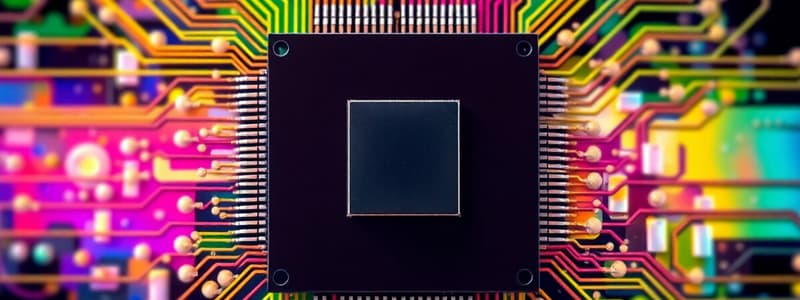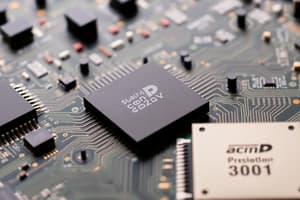Podcast
Questions and Answers
Which of the following is the most accurate description of a microcomputer's fundamental components?
Which of the following is the most accurate description of a microcomputer's fundamental components?
- A CPU chip and memory chips exclusively.
- A microcontroller, I/O ports, and peripheral functions.
- A single chip containing a CPU, memory, and I/O.
- A microprocessor (CPU) chip, input and output chips, and memory chips. (correct)
In a microcomputer system, what is the primary role of the system bus?
In a microcomputer system, what is the primary role of the system bus?
- To directly connect external devices to the CPU.
- To provide a visual display of the program's execution status.
- To carry address, data, and control information for program execution. (correct)
- To manage power distribution across the microcomputer.
What distinguishes Read-Only Memory (ROM) from Random Access Memory (RAM) in a microcomputer system?
What distinguishes Read-Only Memory (ROM) from Random Access Memory (RAM) in a microcomputer system?
- ROM is faster for reading data, while RAM is faster for writing data.
- ROM is non-volatile, retaining data when power is off, while RAM is volatile, losing data when power is off. (correct)
- ROM is volatile and used for temporary data, while RAM is non-volatile and used for permanent storage.
- ROM is used for storing programs, while RAM is used for storing data.
Which of the following best describes the purpose of the control bus in a microcomputer?
Which of the following best describes the purpose of the control bus in a microcomputer?
How does the von Neumann architecture differ from the Harvard architecture in CPU design?
How does the von Neumann architecture differ from the Harvard architecture in CPU design?
What is the role of the Arithmetic Logic Unit (ALU) within a CPU?
What is the role of the Arithmetic Logic Unit (ALU) within a CPU?
Which CPU component holds the address of the data currently being transferred?
Which CPU component holds the address of the data currently being transferred?
During the execution of a program, what is the primary function of the 'Decode' step?
During the execution of a program, what is the primary function of the 'Decode' step?
What distinguishes Reduced Instruction Set Computer (RISC) architecture from Complex Instruction Set Computer (CISC) architecture?
What distinguishes Reduced Instruction Set Computer (RISC) architecture from Complex Instruction Set Computer (CISC) architecture?
What is a key advantage of using the Arduino platform for microcontroller projects?
What is a key advantage of using the Arduino platform for microcontroller projects?
Which of the following is the most accurate description of a microcontroller?
Which of the following is the most accurate description of a microcontroller?
In the context of microcomputers, what is the direction of information transfer in the address bus?
In the context of microcomputers, what is the direction of information transfer in the address bus?
The system clock signals are contained in which bus?
The system clock signals are contained in which bus?
Which of the following is the primary function of the instruction register (IR) in a CPU?
Which of the following is the primary function of the instruction register (IR) in a CPU?
During program execution, what is the role of the Program Counter?
During program execution, what is the role of the Program Counter?
Why is the Arduino IDE described as 'cross-platform'?
Why is the Arduino IDE described as 'cross-platform'?
Which component of the Arduino board indicates whether the board is receiving power?
Which component of the Arduino board indicates whether the board is receiving power?
What type of connector does Arduino Nano use?
What type of connector does Arduino Nano use?
How many analog inputs does the Arduino Leonardo have?
How many analog inputs does the Arduino Leonardo have?
On an Arduino board, what is the purpose of the analog input pins?
On an Arduino board, what is the purpose of the analog input pins?
Flashcards
Microprocessor
Microprocessor
A microcomputer's CPU on a single chip, interfaced with memory and I/O.
Microcontroller
Microcontroller
A single chip containing a CPU, memory, and input/output peripherals.
CPU (Central Processing Unit)
CPU (Central Processing Unit)
Executes instructions and performs arithmetic/logic operations on data.
ROM (Read-Only Memory)
ROM (Read-Only Memory)
Signup and view all the flashcards
RAM (Random Access Memory)
RAM (Random Access Memory)
Signup and view all the flashcards
Input/Output (I/O)
Input/Output (I/O)
Signup and view all the flashcards
System Bus
System Bus
Signup and view all the flashcards
Address Bus
Address Bus
Signup and view all the flashcards
Data Bus
Data Bus
Signup and view all the flashcards
Control Bus
Control Bus
Signup and view all the flashcards
Von Neumann architecture
Von Neumann architecture
Signup and view all the flashcards
Harvard Architecture
Harvard Architecture
Signup and view all the flashcards
Register
Register
Signup and view all the flashcards
Instruction Register (IR)
Instruction Register (IR)
Signup and view all the flashcards
Program Counter
Program Counter
Signup and view all the flashcards
Memory Address Register (MAR)
Memory Address Register (MAR)
Signup and view all the flashcards
Arithmetic and Logic Unit (ALU)
Arithmetic and Logic Unit (ALU)
Signup and view all the flashcards
CPU Program Execution
CPU Program Execution
Signup and view all the flashcards
Arduino
Arduino
Signup and view all the flashcards
RISC
RISC
Signup and view all the flashcards
Study Notes
Microcontrollers
- Microcomputers consist of a microprocessor (CPU) chip, input and output chips, and memory chips for storing programs and data.
- Microprocessors are the CPU of a microcomputer contained in a single chip that interfaces with memory and I/O chips.
- Microcontrollers are implemented in a single chip, containing a CPU, memory, and I/O peripherals, with typical IOPs including I/O units, timers, and AD converters.
Basic Blocks of a Microcomputer
- Central Processing Unit (CPU) executes instructions and performs arithmetic and logic operations.
- Memory stores both instructions and data.
- Read-Only Memory (ROM) retains its content when powered off and is used for instructions and data that do not change.
- Random Access Memory (RAM) loses its content when powered off and is used for programs and data that are temporary and change during execution.
- Input/output (I/O) transfers data between the microcomputer and external devices via I/O ports involving data, status, and control signals.
System Bus
- The system bus contains three buses for address, data, and control information.
- The address bus transfers information in one direction, from the microprocessor to memory or I/O elements.
- The data bus allows data flow in both directions, to and from the CPU.
- The control bus synchronizes the operation of microcomputer elements.
- Microcontrollers need synchronization from a clock or timing circuit.
- System clock signals generate clock periods for instruction executions.
CPU Architectures
- Two types of CPU architectures are used for designing microcontrollers:
- Von Neumann architecture uses a single memory system with shared buses for programs and data, meaning programs and data cannot be accessed simultaneously.
- Harvard Architecture uses separate program and data memory units with separate buses, allowing simultaneous instruction execution and data access.
Main Functional Elements of a CPU
- Registers are volatile storage for bits entered simultaneously or sequentially.
- Instruction Register (IR) stores instructions, with its size determined by the CPU's word size.
- Program Counter contains the address of the instruction or operation code.
- Memory Address Register (MAR) contains the address of data to be transferred.
- Accumulator stores the results of most arithmetic and logic operations.
- Arithmetic and Logic Unit (ALU) performs data manipulations, its size conforms to the word length of the microcontroller.
- The control unit translates or decodes instructions and generates enable signals.
Program Execution Steps
- Fetch: The CPU fetches the instruction from program memory into the instruction register.
- Decode: The CPU decodes the instruction using the control unit to determine its type.
- Execute: The CPU executes the instruction, generating enable signals via the control unit.
RISC vs CISC
- Reduced Instruction Set Computer (RISC) emphasizes software, uses single-clock, instruction and register to register operations, with low cycles per second and larger code sizes.
- Complex Instruction Set Computer (CISC) emphasizes hardware, includes multi-clock operations, and memory-to-memory operations with smaller code sizes and higher cycles per second.
Arduino
- Arduino is an open-source electronics platform with hardware, software/IDE, and a programming language.
Advantages of Arduino
- Inexpensive: Arduino boards are relatively inexpensive.
- Cross-platform: The Arduino IDE runs on Windows, Macintosh OSX, and Linux.
- Simple: Arduino IDE is beginner-friendly and flexible for advanced users.
- Open source: Arduino software and hardware are open-source for extensions.
Basic Arduino Boards
- Arduino Uno has 14 digital I/O pins (6 PWM), 6 analog inputs, USB connection, and power jack.
- Arduino Nano is a compact board that uses a Mini-B USB cable.
- Arduino Leonardo has 20 digital I/O pins (7 PWM, 12 analog), a micro USB connection, and a power jack.
- Arduino Micro is the smallest board similar to the Leonardo.
Parts of an Arduino Board
- Digital pins are used as input or output.
- Pin 13 LED is the only built-in actuator
- Power LED indicates that the board is receiving power.
- ATmega microcontroller is the programmable part of the board.
- Analog in pins read from an analog sensor and converts it to a value to read.
- GND and 5V pins provide +5V power and ground.
- Power connector powers the board using an external supply.
- TX and RX LEDs indicate transmitting or receiving data.
- USB port powers the board and uploads sketches/programs.
- Reset button restarts the program.
Arduino Software (IDE)
- The open-source IDE simplifies coding and uploading, written in Java and based on Processing.
- The Arduino Web Editor allows writing code and uploading to official Arduino boards from a web browser.
Studying That Suits You
Use AI to generate personalized quizzes and flashcards to suit your learning preferences.




